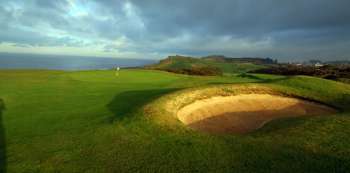When the revered Sir Henry Cotton once said, “Sheringham has a charm that belongs to itself ... and is one of the best kept secrets in golf… Sheringham’s golf course is special,” he was not the first to recognise the unique charm of our Club. Nor was he the last by any means.
Regularly recognised among the Top 100 Courses in the country, every year sees us working hard to enhance Members’ and visitors’ enjoyment of our glorious cliff-top location. And, every year, our teams manage to achieve just that. Both on the course and in our relaxed and spacious Clubhouse.
A large and varied practice area is on hand to prepare you for the course. Then, once on the course, undulating fairways and fast, true greens will test all standards of golfer; while views along the North Sea coast on one side, and of the local steam railway on the other, offer relaxing counter-points to the game itself.
The original nine-hole course opened for play in April 1892. With increasing membership and visitors, an additional nine holes were added and the 18-hole course was opened on 14th May 1898. A Professionals’ Tournament was held on 21st July and won by J. H. Taylor, with a 36-hole total of 157.
Both World Wars saw armed forces using the Sheringham course for exercises and, in World War 2, gun emplacements, pill boxes and look-out towers were erected on and around Skelding Hill. The Clubhouse was used as accommodation for troops and persons displaced from their homes by bomb damage.
Many major course alterations have been made over the last 70 years. The first was the building of a new 17th green into the slope of Skelding Hill near the 18th tee, thus extending the length of the hole. The green of the short 3rd was so close to the cliff path and a public road it posed real danger to the public from wayward balls, so in the 70’s the hole was taken out of use and the opportunity taken to move the 2nd green further down. A new short hole, the 8th, was constructed at the extreme western end of the course and opened on 28th July 1974. The tee to the 8th was later adjusted to accommodate a southerly extension to the 7th green. Cliff falls alongside the 5th green made it necessary to rebuild the green further inland in 1979. In 1987, to accommodate legal agreement for the Norfolk Coastal Path, this was again moved further south. In the 1920’s, flint workings had encroached on land by the sixth green and, over the years, the green was moved southwards in small stages to deal with the needs of access and cliff erosion.
Following the Second World War, military constructions were filled in or removed, and in some cases landscaped over to restore suitable playing conditions.
On the course, the essential watering of tees and greens has progressed from single, hand-placed sprinklers to fixed sprinklers on tees and around greens. In the late 1970’s these were computerised and automated, and in the early 1980’s a borehole was sunk near the Clubhouse to provide water for the system’s storage tanks.
From the golf club website
 this course also has exceptional:
this course also has exceptional:
